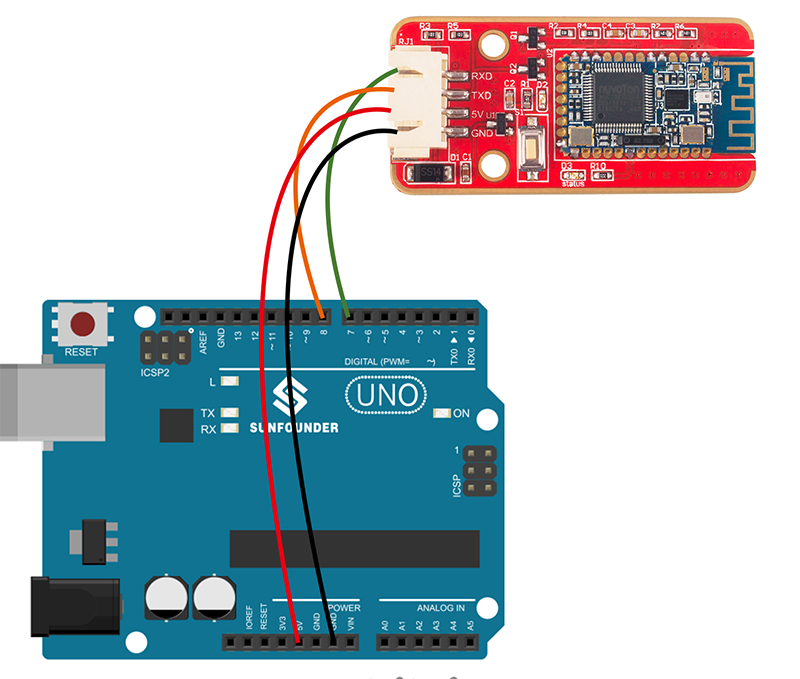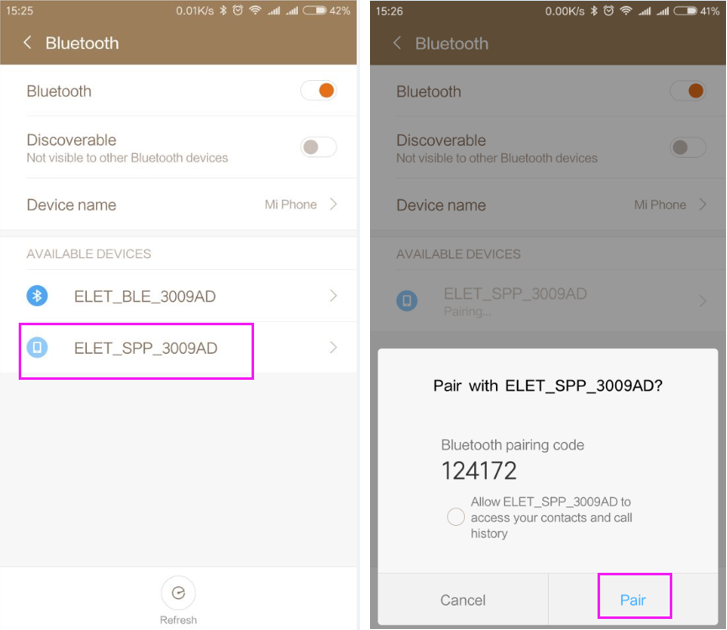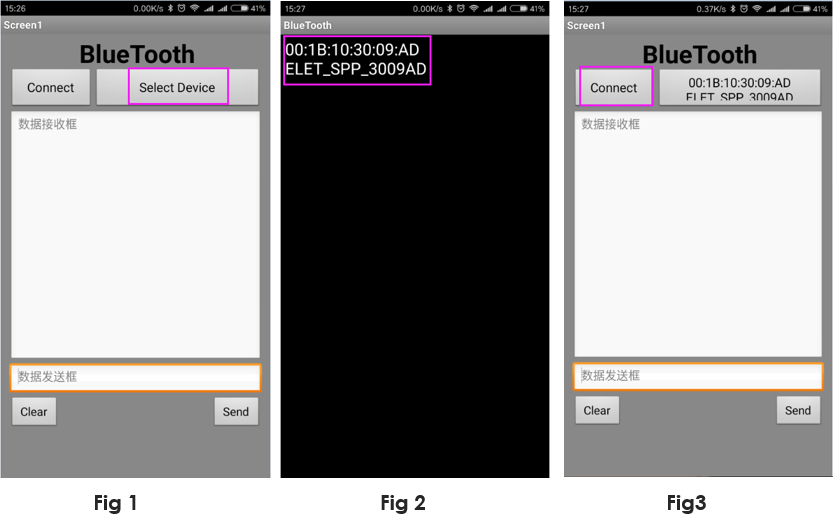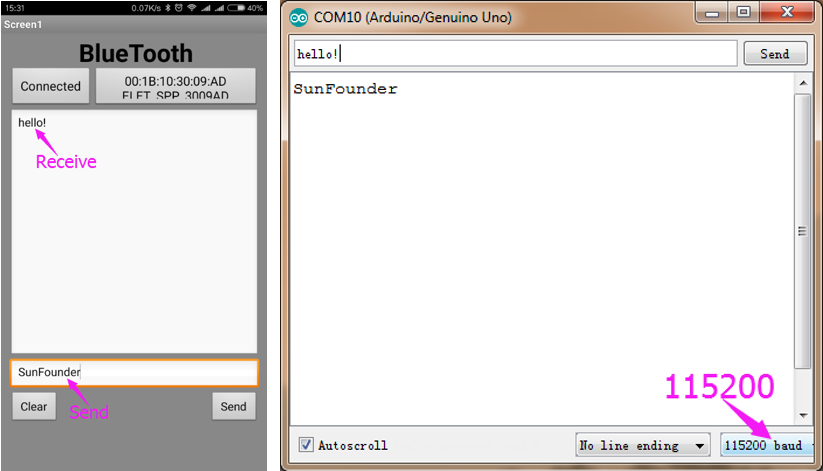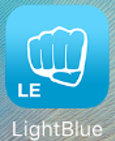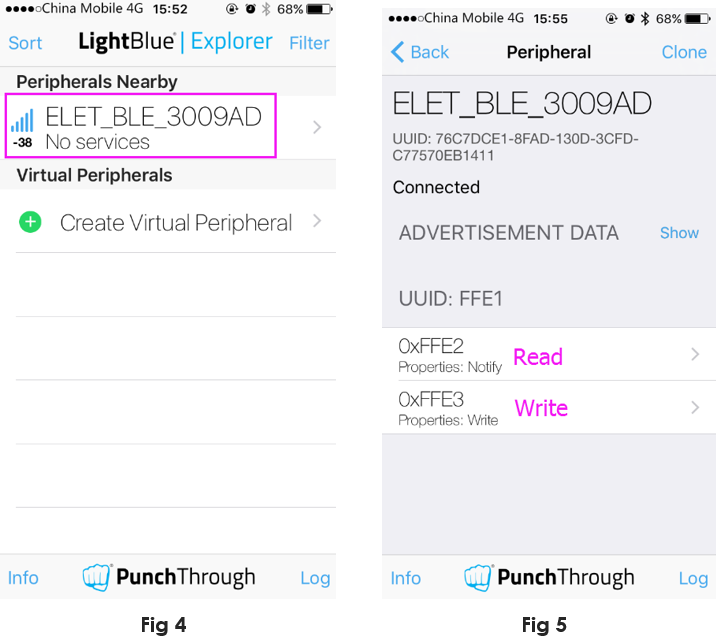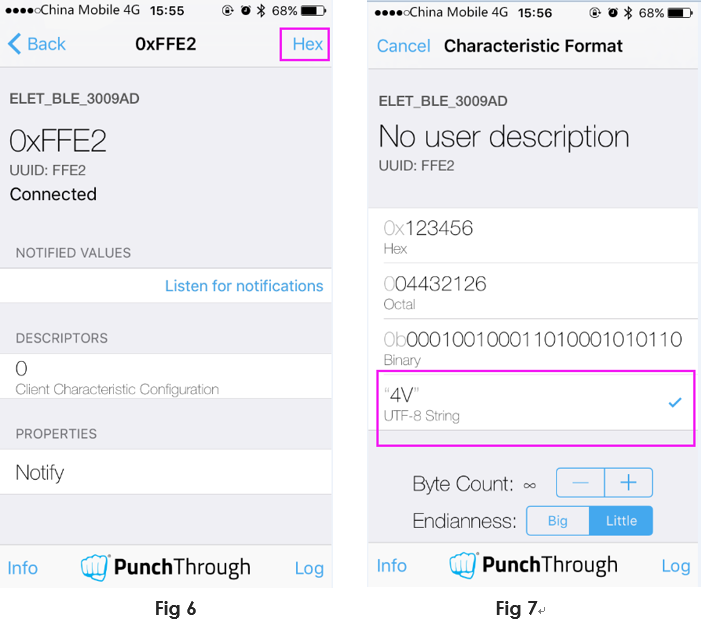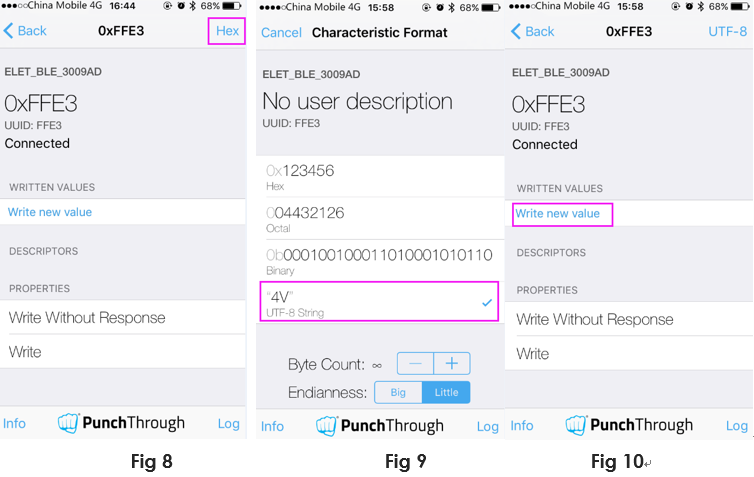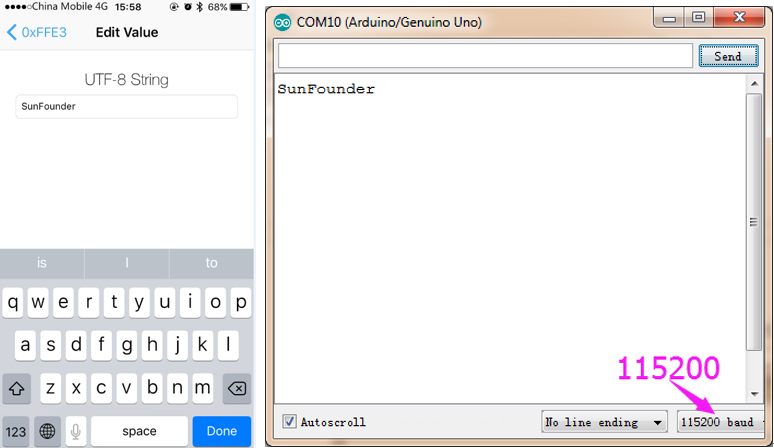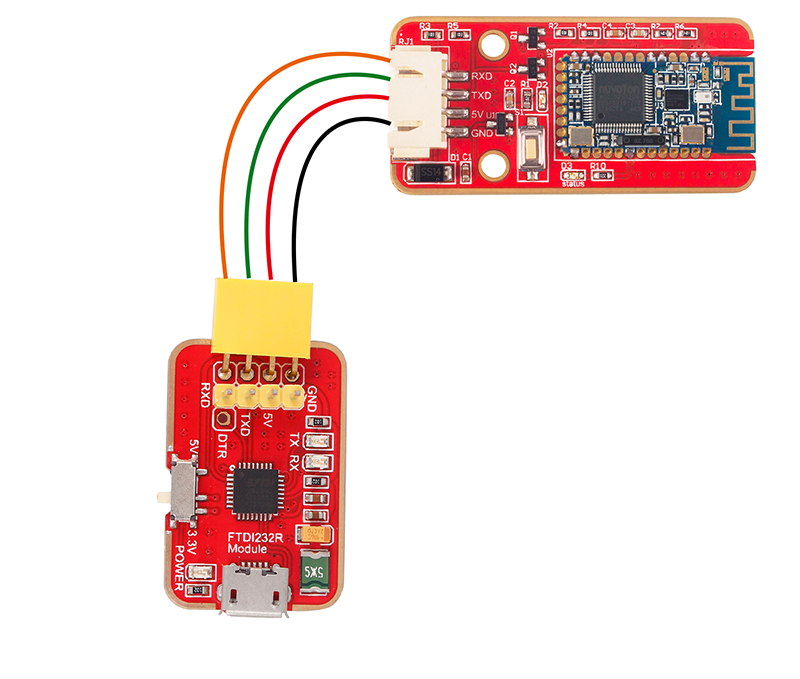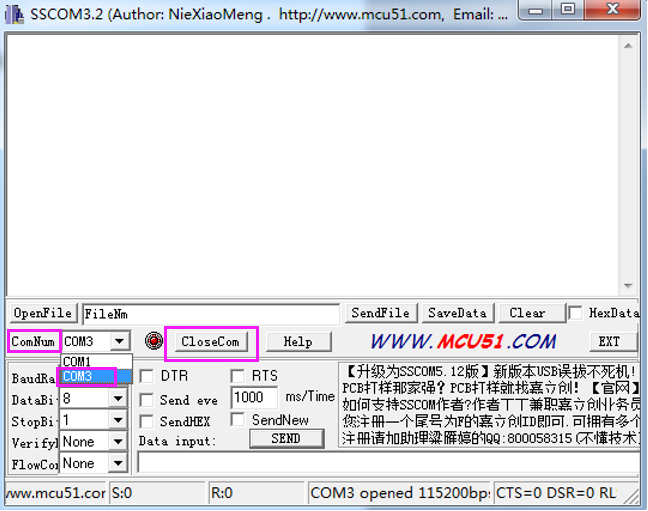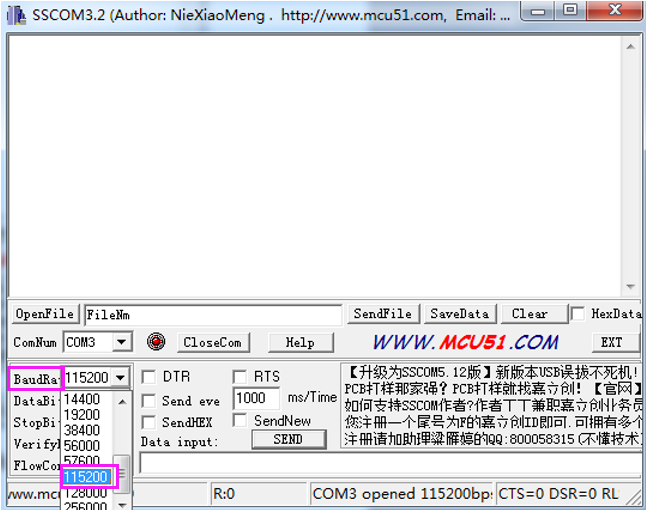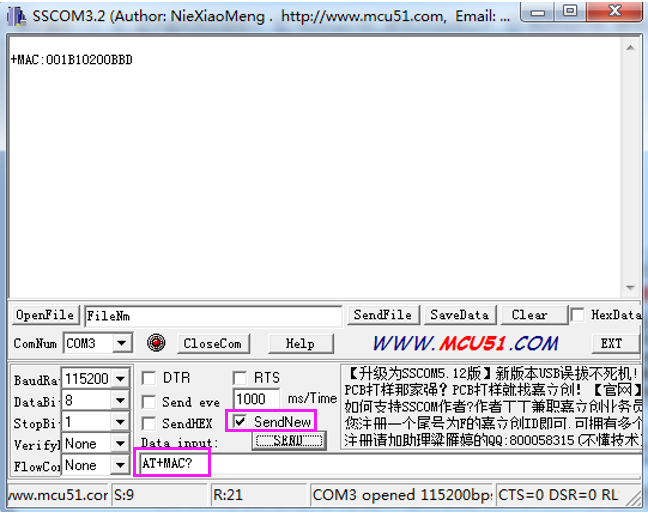Difference between revisions of "ELET114A Bluetooth Module"
(→Test equipment) |
|||
| (9 intermediate revisions by the same user not shown) | |||
| Line 1: | Line 1: | ||
| − | == | + | =='''Introduction'''== |
| − | 1. | + | [[File:Ehasfd.png]]<BR> |
| − | 2. | + | The ELET114A Bluetooth module follows the BT2.1+EDR/3.0/4.0 Bluetooth profile and supports SPP, HID and so on. This module integrates the MCU and Bluetooth chip, thus boasts being high integrated, low consumption, and excellent Bluetooth radio frequency. |
| − | + | =='''Features'''== | |
| − | + | Bluetooth Specification: V2.1+ EDR, BT3.0, BT4.0 (BLE)<br> | |
| + | Operating Frequency Band: 2.4 -2.48GHz unlicensed ISM band<br> | ||
| + | Main Digital Interface: UART<br> | ||
| + | RX Sensitivity: -88dBm<br> | ||
| + | Operating Voltage: +5V 20mA<br> | ||
| + | Operating Temperature: -30 ~ +85 ℃<br> | ||
| + | Dimensions: 50 x 24 x 2mm<br> | ||
| + | =='''Pin Descriptions'''== | ||
| + | '''VCC''': Positive pole of the power source<br> | ||
| + | '''GND''': Ground<br> | ||
| + | '''TXD''': Serial interface, transmitting terminal<br> | ||
| + | '''RXD''': Serial interface, receiving terminal<br> | ||
| + | =='''Using SunFounder Uno'''== | ||
| + | '''Step 1''': Compile and upload the code before building the circuit. | ||
| + | <pre> | ||
| + | /****************************************/ | ||
| + | #include <SoftwareSerial.h> | ||
| − | + | SoftwareSerial mySerial(7, 8); // RX, TX | |
| + | // Connect HM10 Arduino Uno | ||
| + | // TXD Pin 8 | ||
| + | // RXD Pin 7 | ||
| − | + | void setup() { | |
| − | + | Serial.begin(115200); | |
| + | // If the baudrate of the HM-10 module has been updated, | ||
| + | // you may need to change 9600 by another value | ||
| + | // Once you have found the correct baudrate, | ||
| + | // you can update it using AT+BAUDx command | ||
| + | // e.g. AT+BAUD0 for 9600 bauds | ||
| + | mySerial.begin(115200); | ||
| + | } | ||
| − | + | void loop() { | |
| + | char c; | ||
| + | if (Serial.available()) { | ||
| + | c = Serial.read(); | ||
| + | mySerial.print(c); | ||
| + | } | ||
| + | if (mySerial.available()) { | ||
| + | c = mySerial.read(); | ||
| + | Serial.print(c); | ||
| + | } | ||
| + | } | ||
| + | /****************************************/ | ||
| + | </pre> | ||
| + | '''Step 2''': Connect the circuit.<br> | ||
| + | {| class="wikitable" | ||
| + | |- | ||
| + | |Bluetooth 4.0 | ||
| + | |Uno Board | ||
| + | |- | ||
| + | |VCC | ||
| + | |5V | ||
| + | |- | ||
| + | |GND | ||
| + | |GND | ||
| + | |- | ||
| + | |TXD | ||
| + | |Pin 8 | ||
| + | |- | ||
| + | |RXD | ||
| + | |Pin 7 | ||
| + | |} | ||
| − | + | [[File:Bluetoothuno.png]]<br> | |
| − | 3 | + | |
| + | ===Using Android=== | ||
| + | If you are using an Android phone, please follow the steps below: <br> | ||
| + | Step 3: You need to download a Bluetooth 4.0 debugging assistant onto the mobile phone to connect it with the Bluetooth 4.0 module. We've provided the tool in Android. Just download BlueTooth.zip on your smart phone and decompress. Then you can see a file BlueTooth. Enable Bluetooth on your phone and install it.<br> | ||
| − | [[File: | + | [[File:213.png]]<br> |
| − | + | Step 4: Open the installed app. It will directly go to the Bluetooth pairing interface. So first pair your phone and the module.<br> | |
| − | [[File: | + | [[File:Bluetoothconnect.png]]<br> |
| − | + | Step 5: After the pairing is done successfully, you'll be redirected back to the app homepage (Fig 1). Then tap Select Device at the top right corner. On the page, find the Bluetooth and hit it (Fig 2). Tap Connect. When Connect changes to Connected, it indicates that the pairing is good. At the same time the LED indicator on the module will change from blinking to constant lighting.<br> | |
| − | [[File: | + | [[File:Select device.png]]<br> |
| + | |||
| + | Step 6: Tap serial monitor in Arduino IDE, and type in “Hello!”, then you will receive it in the mobile phone. Similarly, SunFounder send by the phone will appear in the serial monitor.<br> | ||
| + | |||
| + | [[File:Hello receive.png]]<br> | ||
| + | |||
| + | ===Use iOS=== | ||
| + | If you are using an iPhone or MacBook, please follow the steps below (iPhone as an example):<br> | ||
| + | Step 3: Go to the App store, search for the application – LightBlue and install.<br> | ||
| + | Step 4: Click/Hit Settings -> Bluetooth, enable the Bluetooth and then open the LightBlue.<br> | ||
| + | |||
| + | [[File:Lightblue.png]]<br> | ||
| + | |||
| + | Step 5: If the Bluetooth is connected successfully, you will see ELET_BLE_XXXXXX as shown in Fig 4. Hit it to connect, then it redirects to the interface in Fig 5. Read and Write Page are separated.<br> | ||
| + | |||
| + | [[File:3009AD.png]]<BR> | ||
| + | |||
| + | Step 6: Read the message<br> | ||
| + | Tap 0xFFE2 to enter into the interface in Fig 6, tap Hex in the top right corner to set the character type.<br> | ||
| + | Among the types (Fig 7), choose UTF-8 String.<br> | ||
| + | |||
| + | [[File:0Xffe2.png]]<br> | ||
| + | |||
| + | Hit Listen for notifications to read the value. Open Serial Monitor, select baud rate 115200, and send “Hello!”, then you will receive it in your iphone.<br> | ||
| + | [[File:Serialmonitor.png]] | ||
| + | |||
| + | Step 7:Write the message<br> | ||
| + | Tap 0xFFE3, and then tap Hex in the top right corner to set the character type.<br> | ||
| + | Among the types (Fig 9), choose UTF-8 String. Hit Write New Value to write a message.<br> | ||
| + | |||
| + | [[File:0xffe3.png]]<br> | ||
| + | |||
| + | Then you can see the message sent from the phone in Serial Monitor.<br> | ||
| + | |||
| + | [[File:Write12.png]]<br> | ||
| − | + | =='''Testing by AT Command'''== | |
| + | Step 1. Build the circuit.<br> | ||
| + | {| class="wikitable" | ||
| + | |- | ||
| + | |Bluetooth Module | ||
| + | |FTDI | ||
| + | |- | ||
| + | |VCC | ||
| + | |VCC | ||
| + | |- | ||
| + | |GND | ||
| + | |GND | ||
| + | |- | ||
| + | |TXD | ||
| + | |TXD | ||
| + | |- | ||
| + | |RXD | ||
| + | |RXD | ||
| + | |} | ||
| + | |||
| + | [[File:FTDI.png]]<br> | ||
| + | |||
| + | Step 2. Set parameters.<br> | ||
| + | Run the serial debugging tool sscom32. Set the parameters first.<br> | ||
| + | 1) Run Open Com to check the COM port. Select the corresponding COM port as shown below.<br> | ||
| + | |||
| + | [[File:Open sscom.png]]<br> | ||
| − | + | 2) Select the correct baud rate. Here we select 115200bps as shown below.<br> | |
| − | + | ||
| − | + | [[File:Baudrate.png]]<br> | |
| − | + | 3) Before sending the command, tick the SendNew checkbox, then input “AT+MAC?” below Data input. If the Bluetooth module works normally, it will return the module’s address as shown below.<br> | |
| − | + | [[File:Sendnew.png]]<br> | |
| − | ''' | + | 4) For more directives, please check the Datasheet of ELET114A.<br> |
| + | =='''Resources'''== | ||
| + | [http://wiki.sunfounder.cc/images/b/b2/Sscom32E.zip Sscom32E][[File:ZIP.jpg]]<br> | ||
| − | + | [http://wiki.sunfounder.cc/images/e/ed/BlueTooth.zip BlueTooth][[File:ZIP.jpg]]<br> | |
| − | + | ||
| − | [[File: | + | [http://wiki.sunfounder.cc/images/f/f1/ELET114A_Datasheet_v1.0.pdf ELET114A_Datasheet] [[File:PDF.jpg]]<br> |
Latest revision as of 08:18, 23 March 2017
Contents
Introduction
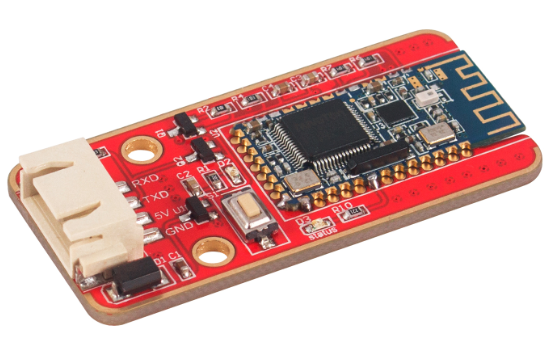
The ELET114A Bluetooth module follows the BT2.1+EDR/3.0/4.0 Bluetooth profile and supports SPP, HID and so on. This module integrates the MCU and Bluetooth chip, thus boasts being high integrated, low consumption, and excellent Bluetooth radio frequency.
Features
Bluetooth Specification: V2.1+ EDR, BT3.0, BT4.0 (BLE)
Operating Frequency Band: 2.4 -2.48GHz unlicensed ISM band
Main Digital Interface: UART
RX Sensitivity: -88dBm
Operating Voltage: +5V 20mA
Operating Temperature: -30 ~ +85 ℃
Dimensions: 50 x 24 x 2mm
Pin Descriptions
VCC: Positive pole of the power source
GND: Ground
TXD: Serial interface, transmitting terminal
RXD: Serial interface, receiving terminal
Using SunFounder Uno
Step 1: Compile and upload the code before building the circuit.
/****************************************/
#include <SoftwareSerial.h>
SoftwareSerial mySerial(7, 8); // RX, TX
// Connect HM10 Arduino Uno
// TXD Pin 8
// RXD Pin 7
void setup() {
Serial.begin(115200);
// If the baudrate of the HM-10 module has been updated,
// you may need to change 9600 by another value
// Once you have found the correct baudrate,
// you can update it using AT+BAUDx command
// e.g. AT+BAUD0 for 9600 bauds
mySerial.begin(115200);
}
void loop() {
char c;
if (Serial.available()) {
c = Serial.read();
mySerial.print(c);
}
if (mySerial.available()) {
c = mySerial.read();
Serial.print(c);
}
}
/****************************************/
Step 2: Connect the circuit.
| Bluetooth 4.0 | Uno Board |
| VCC | 5V |
| GND | GND |
| TXD | Pin 8 |
| RXD | Pin 7 |
Using Android
If you are using an Android phone, please follow the steps below:
Step 3: You need to download a Bluetooth 4.0 debugging assistant onto the mobile phone to connect it with the Bluetooth 4.0 module. We've provided the tool in Android. Just download BlueTooth.zip on your smart phone and decompress. Then you can see a file BlueTooth. Enable Bluetooth on your phone and install it.
Step 4: Open the installed app. It will directly go to the Bluetooth pairing interface. So first pair your phone and the module.
Step 5: After the pairing is done successfully, you'll be redirected back to the app homepage (Fig 1). Then tap Select Device at the top right corner. On the page, find the Bluetooth and hit it (Fig 2). Tap Connect. When Connect changes to Connected, it indicates that the pairing is good. At the same time the LED indicator on the module will change from blinking to constant lighting.
Step 6: Tap serial monitor in Arduino IDE, and type in “Hello!”, then you will receive it in the mobile phone. Similarly, SunFounder send by the phone will appear in the serial monitor.
Use iOS
If you are using an iPhone or MacBook, please follow the steps below (iPhone as an example):
Step 3: Go to the App store, search for the application – LightBlue and install.
Step 4: Click/Hit Settings -> Bluetooth, enable the Bluetooth and then open the LightBlue.
Step 5: If the Bluetooth is connected successfully, you will see ELET_BLE_XXXXXX as shown in Fig 4. Hit it to connect, then it redirects to the interface in Fig 5. Read and Write Page are separated.
Step 6: Read the message
Tap 0xFFE2 to enter into the interface in Fig 6, tap Hex in the top right corner to set the character type.
Among the types (Fig 7), choose UTF-8 String.
Hit Listen for notifications to read the value. Open Serial Monitor, select baud rate 115200, and send “Hello!”, then you will receive it in your iphone.
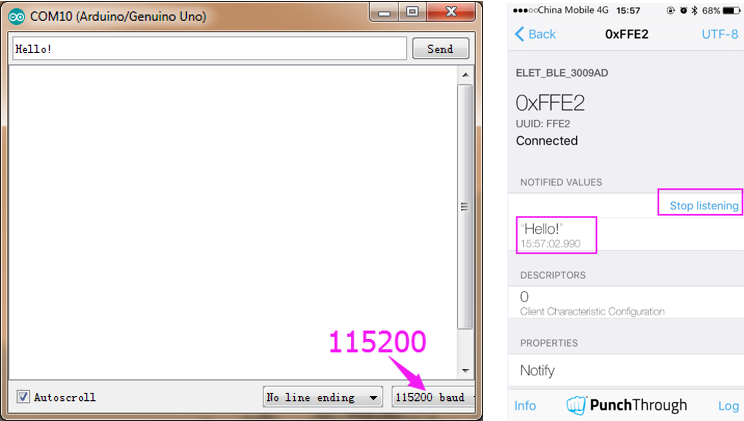
Step 7:Write the message
Tap 0xFFE3, and then tap Hex in the top right corner to set the character type.
Among the types (Fig 9), choose UTF-8 String. Hit Write New Value to write a message.
Then you can see the message sent from the phone in Serial Monitor.
Testing by AT Command
Step 1. Build the circuit.
| Bluetooth Module | FTDI |
| VCC | VCC |
| GND | GND |
| TXD | TXD |
| RXD | RXD |
Step 2. Set parameters.
Run the serial debugging tool sscom32. Set the parameters first.
1) Run Open Com to check the COM port. Select the corresponding COM port as shown below.
2) Select the correct baud rate. Here we select 115200bps as shown below.
3) Before sending the command, tick the SendNew checkbox, then input “AT+MAC?” below Data input. If the Bluetooth module works normally, it will return the module’s address as shown below.
4) For more directives, please check the Datasheet of ELET114A.
